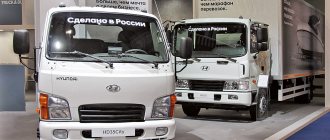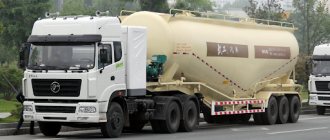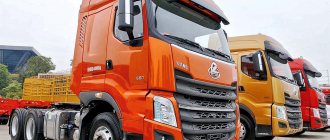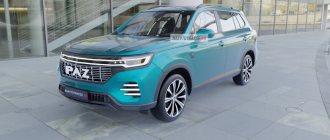Analysis of the primary truck market
The leader of the Russian truck market, as in 2016, is the products of the domestic automobile corporation KAMAZ. At the end of 2022, the Kama Automobile Plant accounts for 33% of the total volume. In quantitative terms, this figure corresponds to 26.4 thousand units, which is 30.6% more than in 2016. At the same time, according to the corporate report, the divisions of KAMAZ’s unified technological cycle produced 4,238 vehicle sets in December. In total, 39,525 units were produced during the year - 12% more than in the 12 months of 2016. In second place is another Russian one with 7.8 thousand cars, an increase over the year of 6.9%.
Nizhny Novgorod machine builders have high hopes for new models of medium-duty and light commercial vehicles “GAZon NEXT” and “GAZelle NEXT”, the production of which started in December 2017. According to the manufacturer, new developments provide the company with access to new segments of the Russian market, where today only foreign manufacturers are present. Third place goes to the Swedish company Volvo, whose figures are at the level of 6 thousand units, an increase of 246.6%. The top five also includes cars from the brands Scania (5.7 thousand units, +126.2%) and Mercedes-Benz (5.6 thousand units, +173.1%). It is worth noting that the entire top ten leaders at the end of 2022 demonstrate market growth, and for half it is expressed in triple digits. The DAF brands stood out with an increase of 286.5% and MAN (+112.8%). The model structure of the rating was also topped by KAMAZ.
The updated KAMAZ 43118 truck became the most popular on the market: its figure was 5,861 units. Next come: Mercedes-Benz Actros (5.1 thousand units, +192.8%), GAZon Next (5 thousand units, +12.9%), KAMAZ 65115 (4.7 thousand units, +26.8%) and KAMAZ 6520 (4.5 thousand units, +46.1%). The TOP 10 also included: Volvo FX, DAF TRUCKS XF SERIES, MAN TGS. It is necessary to mention that the top ten leading models show only positive market dynamics. As for the structure of the truck fleet by federal districts, the highest density of CV-HCVs is observed in the Central, Southern, and Volga districts. Thus, in Moscow and the Moscow region there are 321.8 thousand cars registered, or 8.72% of the total, in the Krasnodar Territory and the Rostov region 246.2 thousand units (6.7%).
This location of the regions is due to a number of factors, including: high population concentration, considerable per capita income, active business environment and a developed road network and the presence of large metropolitan areas.
Commodity transport market: results of the first half of 2022
Having gained good momentum last year, the production and sales of commercial vehicles are showing positive dynamics in the first half of this year. However, not everything is as rosy as it seems at first glance. In any case, there are factors that have a restraining influence on market development.
Valery Vasilyev
The main reasons for the slowdown in growth in the industry are considered to be a decrease in government support and the weak purchasing power of the population. But in general, experts assess the situation in production and sales positively. Avtopark magazine analyzed reports from analytical agencies for the first half of 2022.
FIGURES AND FACTS
Let's start with production statistics, namely light trucks. According to ASM Holding, the production volume of light commercial vehicles (LCV) in January-June increased by 13.4%, reaching 58.8 thousand units. The largest production volume was recorded by GAZ (+22.4% compared to 2022), UAZ (+36.6%), AvtoVAZ (+56.9%), Ford Sollers Yelabuga (+55.5%), PKF "Luidor" (+34.8%), ST "Nizhegorodets" (+21.5%) and "VIS-Auto" (+30.1%).
The production of trucks, including vehicles of the N1 category, amounted to 71.7 thousand units, which is 5.6% more than in the same period in 2022. The production of domestic trucks increased by 0.7%, reaching 58.3 thousand units. The growth in truck production was ensured by: GAZ (+10.3%), KAMAZ (+10.4%), AZ Ural (+7.7%), VIS-Auto (+30.1%), Becema "(+24.8%), "Spectrum Auto" (+5.7%) and "Chaika-NN" (+5.2%).
The production of foreign cargo vehicles in January-June increased by 34.1%, amounting to 13.4 thousand units. Increased production of trucks: Ford Sollers Yelabuga (+62.6%), Volvo Vostok (+62.6%), Daimler KAMAZ Rus (+41.3%), Iveco-AMT (+94. 5 %).
The share of foreign brands in the total production of trucks in Russia amounted to 18.7% (in January-June 2022 - 14.7%). Manufacturing enterprises shipped 68.7 thousand units of equipment to consumers (+6.3%).
Production and export of trucks (including light trucks) for 2010–2025, thousand units.
The production of buses, including models of the M2 category, increased by 2.4%, 18.6 thousand units were produced. Of the total number of buses produced, the share of domestic brands was 14.2 thousand units (+4.4%), and the production of foreign cars was 4.4 thousand (-3.8%). Increased production of passenger cars PAZ (+4.1%), PKF Luidor (+34.8%), ST Nizhegorodets (+21.5%), Ford Sollers Yelabuga (+19.3%), NefAZ (+20.9%) and Volgabas (+25.7%). The share of foreign brands in the total production of buses in Russia was 23.6%. During the first half of the year, bus manufacturers shipped 18.3 thousand vehicles to consumers (+2.2%).
Production and export of buses (including minibuses) for 2010–2015, thousand units.
The market volume of new LCVs in Russia amounted to 52.9 thousand units, which is 5.4% higher than a year ago, reports Autostat. The leader of the LCV market has traditionally been the GAZ brand, which accounted for over 45% of the total volume. In quantitative terms, this amounts to 23.9 thousand units, 9.5% more than a year earlier. In second place is UAZ, whose figure decreased to 7.8 thousand vehicles (-30.6%). Lada closes the top three, as before, with 5.1 thousand units; +8.9%. The top five also included Ford (4.8 thousand units, +59.0%) and Mercedes-Benz (4.3 thousand units, +15.2%). Only two brands from the Top 10 demonstrate negative market dynamics: UAZ (-30.6%) and Fiat (-15.7%).
In the model structure, the leadership belongs to Gazelle Next, whose market volume amounted to 14.1 thousand units, which is 23% more than a year earlier. Second place is occupied by GAZ-3302 with an indicator of 5.1 thousand units (-1.3%). This is followed by Ford Transit (4.5 thousand units, +52.3%) and Lada Largus van (4.2 thousand units, +7.9%).
Russian Automotive Market Research agency provides slightly different figures. According to him, the market for new LCVs in January-June 2018 grew by 6.5% compared to the same period in 2022 and amounted to 57.7 thousand units. The GAZ brand occupied 41.2% of the Russian market for new light commercial vehicles, and its sales growth was 10.2%. Among foreign LCV brands, Ford remained the most popular brand on the market with a share of 8.3%.
For trucks over 3.5 tonnes, this sector continues to show the highest growth rate among commercial vehicles at 20.1%. The market volume of new trucks amounted to 37.9 thousand units. KAMAZ remains the favorite in this market segment: sales of trucks from Naberezhnye Chelny, compared to the result of a year ago, increased by 6.4% (13,826 vehicles sold). GAZ took second place (4 thousand cars; +12.2%). The top three is completed by Volvo Trucks (3.2 thousand units), whose market volume has doubled. The top five also included Swedish Scania (2.7 thousand units, +38.2%) and German MAN (2.2 thousand units, +47%).
But statistics from Russian Automotive Market Research show that over the six months of 2022, 37.4 thousand new trucks with a gross weight of over 6 tons were sold in Russia. Compared to the same period in 2022, the market grew by 20.3%. The growth rate of the new truck market continues to slow. Thus, the increase in truck sales in May 2022 was 9.1% compared to the same period last year, and in June - 0%.
The most monopolized segment of the Russian commercial transport market - buses - shows the most optimistic indicators. Sales of new buses increased by 32.3% and amounted to 7,077 units. During the reporting period, 699 units of foreign-made buses were sold on the Russian market. (+58.5%), including 126 units sold in June. The number of buses sold of Russian brands is much larger: 6378 units. (+30%). The PAZ brand remains the sales leader in the new bus market, having sold 3,130 units of equipment and improving last year’s sales result by 9.5% year-on-year. The ranking of the most successful bus manufacturers by sales also included LiAZ (1132 units, +36.6%), GAZ (641 units, +1680%), NefAZ (524 units, +24%) and MAZ (374 units). , +46.7%).
Market and forecast for large class buses (registration).
In the top ten bus brands on the Russian market, Chinese Yutong with a 3-fold increase - up to 0.3 thousand, of which the lion's share was model 6119 with an increase of 2.7 times. It should be noted that buses from China showed impressive growth rates in the first half of this year (for example, Golden Dragon with 4-fold growth), although with relatively low actual sales volumes. Their key bet in Russia was intercity airliners, which replaced used European-made cars.
Market of trucks with a gross vehicle weight over 14 tons, primary and secondary registrations, thousand units.
FORECASTS AND PROSPECTS
According to calculations by ASM Holding experts, by the end of this year Russian enterprises will produce 125 thousand light commercial vehicles (+1.3% to the 2022 result), 167 thousand trucks, including chassis and light trucks (+3. 7%), among which 145 thousand will be cars of domestic brands, and 22 thousand - products of foreign brands, 44 thousand buses (+2.3%), including 35 thousand units of Russian brands and 9 thousand - foreign .
Meanwhile, if we talk about sales, in 2022 the limiting factor will be a reduction in government support measures. For example, funding for the program of preferential car loans and preferential leasing, including targeted ones, will amount to only 16 billion rubles. As a result, the share of commercial vehicle lease sales under subsidy programs will be slightly more than 10% versus almost 30% in 2022.
A not very pleasant surprise for foreign manufacturers was the increase in recycling fees for cars. Although this measure, according to the authorities, is aimed at protecting the environment, market participants regard it as a restriction on imports, since for domestic producers the fee is compensated by the state. On average, the fee increased by 15%, and for some categories of vehicles did not change. However, the imported LCV segment has been hit the hardest, leading to higher prices. Therefore, the competitiveness of imported cars on the market decreases, and a redistribution occurs in favor of locally produced products.
It is expected that in 2022 the Russian commercial vehicle market will show moderate growth of 5–10%. The main drivers of growth are government subsidies and subsidies for cars produced in Russia, as well as demand for cars with a low total cost of ownership. Interest in light commercial vehicles has increased with the revival of the small and medium-sized business sector. GDP growth of 2% and a decrease in loan rates provide grounds for such an assessment.
According to PwC experts, in 2022 the growth in total LCV sales will be 12% and reach 121 thousand units. The main factors influencing this market segment include the fact that as the economy recovers, the activity of small and medium-sized businesses is growing. As for the total sales of trucks, it will be 10%, the market will reach 88 thousand units. In the next few years, the share of premium price segment trucks in the market will increase, and the share of foreign truck brands will also continue to grow.
The demand for new buses will depend on the strategy for renewing the worn-out fleet. According to the PwC forecast, this year the growth in total sales of passenger cars will be 16% and reach 13.6 thousand units. The wear and tear of the park is of considerable importance here. Over 40% of all cars are over 15 years old and need to be updated in the near future.
Sales of new buses in 2022, according to the analysis of Russian Automotive Market Research, will show positive dynamics (+5.2% according to the base forecast scenario), in quantitative terms they will reach 12.4 thousand units. Small class cars will remain the dominant market segment, but their share will decline in the medium term. The market share of large-class models is projected to grow to 26% in 2023.
It is noted that the primary market for commercial transport is growing mainly due to Moscow, St. Petersburg and large logistics centers of Russia, such as Novosibirsk, Yekaterinburg, Rostov.
The editors recommend:
Why do piston rings stick and how to prevent it?
A traffic police officer searched my car: did he have the right to do so?
Russians may be left without foreign cars: Western automakers have stopped supplying cars to our country
A ship that was transporting cars to Russia was detained in France
Half of the car factories in Russia have closed
Discussion Cancel
Analysis of the secondary market for trucks
The leader in the secondary truck market, as before, was KAMAZ with 71.5 thousand purchase and sale transactions, which is 25.8% of the total volume. True, a year earlier this figure was higher by 1%. The second place is occupied by the domestic GAZ with 27.7 thousand trucks (+ 1%). The top three is closed by the Belarusian MAZ, its figures amounted to 25.4 thousand units (+ 0.5%). The TOP 5 included: Russian ZIL with 16.4 thousand resold trucks, which is 15% less than in 2016, as well as Swedish Volvo with 15 thousand sales (-3%). The most popular model on the used equipment market is KAMAZ 65115: 9.1 thousand transactions (- 7%). In second place was Volvo FH with 8.3 thousand cars (-0.5%). The third and fourth positions also remained with the Kama Automobile Plant with its KAMAZ 55111 and KAMAZ 5320 trucks - 6.6 thousand and 6.5 thousand units, respectively. GAZ 3309 closes the ranking of the most popular brands with 5.9 thousand resold copies (-0.5%). It is worth mentioning that the average age of the cargo fleet in the Russian Federation is 19 years, while in Europe or the USA this figure is no higher than 5-7 years.
Prospects for the Russian truck market in 2022
According to experts from the AvtoSpetsTsentr Group of Companies, the prospects for sales growth are low - and for medium-duty trucks in Russia in 2022, rather positive. One of the objective reasons for growth may be the opening of production facilities in Russia. For example, with the support of the government of the Moscow region, construction of the Hino plant will begin in the spring of 2022, which will significantly increase the competitiveness of the brand, as it will allow, on the one hand, to avoid import duties and reduce the cost of production, and on the other hand, to qualify for state support in the form of indexation of the recycling fee. The growth of the truck market is also driven by increased corporate sales. For several years, the economic crisis has hampered the modernization of vehicle fleets, not only among small and medium-sized businesses, but also among large players who will become drivers of market growth in 2022. Government programs to support demand, including targeted programs such as “Own Business”, “Russian Farmer” and others, will also serve as an incentive to purchase new commercial vehicles. A profitable scheme for purchasing freight transport for the needs of small and medium-sized businesses – leasing – is gaining popularity. In 2017, it accounted for up to 40% of sales. If we talk about the regional structure of sales in the primary market of trucks, then growth is mainly due to Moscow, St. Petersburg and large logistics centers of Russia, such as Novosibirsk, Yekaterinburg, Rostov. In turn, up to 70% of sales on the secondary market occur in cities with a population of up to 500 thousand people.
It is worth noting that the average cost of selling a used truck is 2.7 million rubles, while 2 million vehicles have been in use for 15 years or more. It is obvious that another prerequisite for the growth of the commercial vehicle market in 2018 will be the need to update the corporate vehicle fleet
The current cargo salon in Hannover turned out to be perhaps the most predictable and least interesting during the entire existence of the exhibition.
Almost the entire “Big Seven” simply brought standard cars; there were almost no specialized specialists at all. Although, of course, there were some new products. The main intrigue was connected with two groups that dominate the cargo world. Traton concern acted as an opponent of the Daimler empire
. We will have a separate article about Traton, but for now we will focus on other new products.
01.
The highlight of the Mercedes stand was, of course, the updated Actros – the world premiere of the year. It has a lot of new advantages - fuel savings of up to 5%, semi-automatic movement (Active Drive Assist system), emergency braking system (Active Brake Assist 5), connectivity interface and Multimedia Cockpit multimedia concept.
02.
Best of all, the MirrorCam system comes as standard. Which means rear view cameras and monitor screens in the cockpit instead of outside mirrors and an instrument panel. At the exhibition it was possible to try out innovations on a mock-up, which is what we did. Of course it breaks my brain. At first it is completely inconvenient, but, apparently, it will become a standard in the future. However, at first we also got used to smartphones through withdrawal, but now we can’t imagine ourselves without them.
03.
Yes, and purely externally, of course, it is perceived as a revolutionary, completely new model (sarcasm). Apparently, at the next Hannover they will show another unprecedented innovation, such as headlights that turn with the steering wheel, or parking sensors for a semi-trailer with a camera. Or what else is there in the car stash?
04.
Traditionally, Daimler has demonstrated its global ambitions. Under the nameplate of the overseas Freightliner they rolled out the familiar Econic. We believe that he will not have much success, and in three years he will quietly disappear from the American program. The same Freightliner has already broken off with its own analogue called Condor, and Mercedes itself has failed with Unimog in the USA.
05.
It must be said that in the field of advanced technology for trucks, fellow countrymen-competitors from MAN went a little further than Daimler and brought an electric prototype. “The low seating position, significant cabin glazing and video assistants provide the driver with a full overview of the surrounding situation on the road,” the press release says. Well, yes, you can’t lag behind your neighbors in the concern, because the low-cab urban Scania is already in production. At the same time, MAN already had such vehicles (mainly garbage trucks) in its program. True, of course, they were not electric.
06.
By the way, more about electro-MANs. We have already talked about the experimental, but close to the series, MAN eTGM, but electric trucks based on MAN units have been mass-produced for a couple of years now by the German company Framo (and under its own brand). She had her own stand at the IAA. The tractor in the photo is not new, but few people here know about them.
07.
The Volvo team also brought an interesting electric prototype.
Called Vera,
the autonomous electric vehicle is connected to a cloud service and a vehicle control center. An abundance of sonars and cameras allows you to determine the current position of the car with an accuracy of centimeters, monitor and analyze in detail what is happening to other road users, and accurately respond to changes in the situation.
08.
The appearance is certainly futuristic, but the idea itself is not so new, given that autonomous trucks from Volvo (and other brands) are being actively tested around the world. At the stand itself, for some reason the car was hidden behind a screen and many visitors probably didn’t even find or see it.
One of the, so to speak, sensations of IAA-2018 is that for the first time in the history of the Truck of the Year competition, a Turkish truck became the winner of this title.
09.
Meet the 2022 Truck of the Year,
Ford F-Max
. For the first time since its birth in 1982, it received a completely new cabin with a width of 2500 mm. Its own engine has also been updated; with a volume of 12.7 liters, it develops power up to 500 hp. The gearbox is traditional ZF. The appearance, however, is rather scary, and resembles a deep Chinese redesign of Volvo in the front and Scania in the side.
10.
Navy
, did not stand aside either .
Several new trucks called Tugra
. Apart from the fact that the name means “obverse” or the monogram of the Sultan, nothing is known about the car. We can only say that the design of the new series, unlike the previous one, was clearly not done by the Pininfarina studio. Although they managed to achieve a certain originality and “dissimilarity from anyone else”.
The most interesting new product for us was located at the GAZ Group stand. Nizhny Novgorod residents in Hannover were the only manufacturers of trucks from Russia.
11.
The Gazovians continue to develop the theme of all-wheel drive vehicles - here they brought the “Vepr” and “Sadko” of the Next generation, well known to our readers, and even in right-hand drive. In Western Europe, this niche has long been firmly occupied by local authorities, but GAZ has no intention of competing with the Big Seven. The purpose of the show in Hannover is to attract potential clients from third world countries, of which there are many representatives at the IAA.
Traditionally, small special manufacturers of original all-wheel drive chassis for special equipment show their products in Hannover. But this year there were very few such cars.
12.
The court Mercedes sawyer
Paul
showed another non-standard
Zetros
in the 8x8 version, this time with a “tridem” at the rear.
13.
And the most impressive exhibit of the entire exhibition was the Belgian oil-industrial
Mol HF8066
with a cabin from Renault Premium. The mass of this giant with a load, under the platform of which one could walk without bending down, can be 230 tons.
The exoticism that Hanover used to be rich in was now sorely lacking. Some well-known non-standard manufacturers were not present at all this time. But be that as it may, the IAA is still the main truck exhibition in the world. The only pity is that this event is no longer as breathtaking as before, and the heart does not flutter. Are we getting old?











